Things are settling down for me at the Carsington ABB events, a routine neatly developing. The vibe was pretty good this week, a quieter day so we could spend more time on each visitor and impress on them all things wonderful about the birds. I didn't stick around to wait for the actual figure, but it's clearly we had a fair number of people signing up not only for the RSPB newsletter, they were going for full membership too. What to say other than, SCORE!
The water level is very low at Carsington which seems at odds with the summer we've had, especially since her sister reservoir at Ogston is absolutely brim full. No complaining from us though, low levels means more exposed mud, and autumn winds permitting a plentiful area for passage waders to feed. That said, the only waders we had on Tuesday were Lapwing and one elusive Green Sandpiper.
Up on the hillside the Little Owls dutifully showed well through a scope, a cosy threesome of eclipse Red-crested Pochard kept in broad view (with at least two more males spread elsewhere), a juvie Common Tern briefly passed through, a pair of Raven showed over distant woodland and a female Shoveller was a blink and you missed it bird for the day list. We ended with 42 species from the Wildlife Centre, which is a about par.
Back at home the local rounds on my bike turned up a Yellow-legged Gull at Pleasley Colliery Nature Reserve. The small lake up there has always been a hotspot for local rarities, although these days with increased visitor numbers - mostly dog-walkers - the nearby birding fraternity seems to have rather turned interests away from it, many grumbling of the constant disturbance. For me it's a pleasant bike ride and at the site I've picked up Ruff, Wheatear, Yellow Wagtail and Little Ringed Plover, so it's clear to my mind it's still worth a regular look, and I think quite under-watched. For the two years I've been visiting I could count on the fingers of one hand how many occasions somebody has been in the members-only bird-hide.
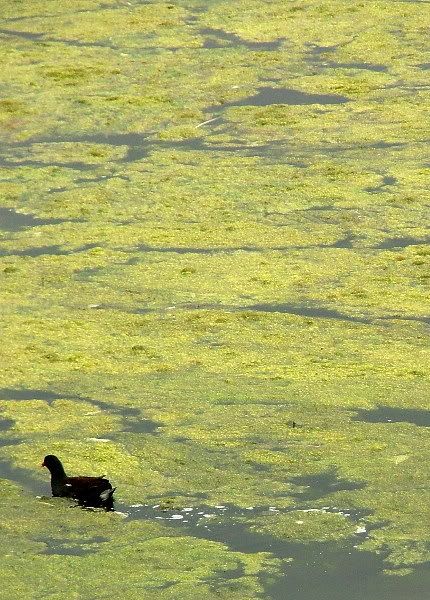
On the other side of town King's Mill Reservoir looks in poor health with another summer bloom of algae. I'll let some minutes from a local council meeting explain the problem:
The problem arises because of an upset to the very delicate balance between algae, fish, and bacteria in the water. These three denizens of natural water depend upon each other in a triangular relationship which can be upset by pollution.
Algae -- a collection of microscopic plants -- use sunlight to photosynthesise food from nutrients. These nutrients are provided by the bacteria in the water which act upon the waste products from fish, converting them into a form which the algae can use as food. In turn the algae provide food for the fish, and they also serve both the fish and the bacteria by oxygenating the water as a by-product of their photosynthesis.
THE IMBALANCE
What causes the upset is that additional nutrients get into water through pollution, and this causes massive growth of the algae, producing what is often called an algae bloom. This can spread over the surface of the water, and can be made worse by the growth other surface plant life.
It might be thought that this is actually a good thing, for after all it provides more food for the fish, which might therefore be expected to thrive. Such is indeed the immediate effect, but it does not last. The algae grows to such an extent that there is too much of it, with layers of algae growing below other layers. The upper layers of algae shelter the lower layers from sunlight, and the latter cannot therefore photosynthesise their food. They they die. The bacteria in the water then act upon the dead algae, and in the process they use up masses of oxygen from the water.
This de-oxygenation caused by the action of bacteria upon the dead algae obviously results in the death of the fish, which needs that oxygen. The dead fish sink to the bottom, where further bacterial action changes the dead matter into sludge, and further depletes the water of oxygen.
This sludge can, in extreme cases, turn what was once a living pond or lake into actual swampland.'
Periodically new aerating rafts have been placed in areas where road run-off and other sources of pollution reach the reservoir, though clearly that measure just doesn't work well enough. Looks like there are no easy answers to this problem.
For now the bird life can tolerate the algae, although it has been quiet this week. The best bird yesterday was a Snipe for example. Still if you have birds you're never short of action, and the highlight was a meeting of minds between a Cormorant and a Heron...
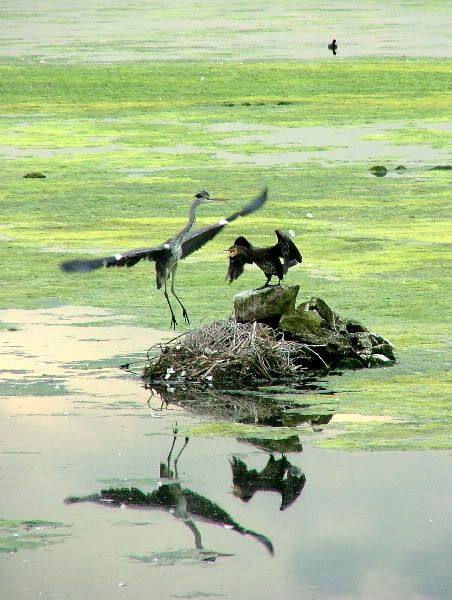

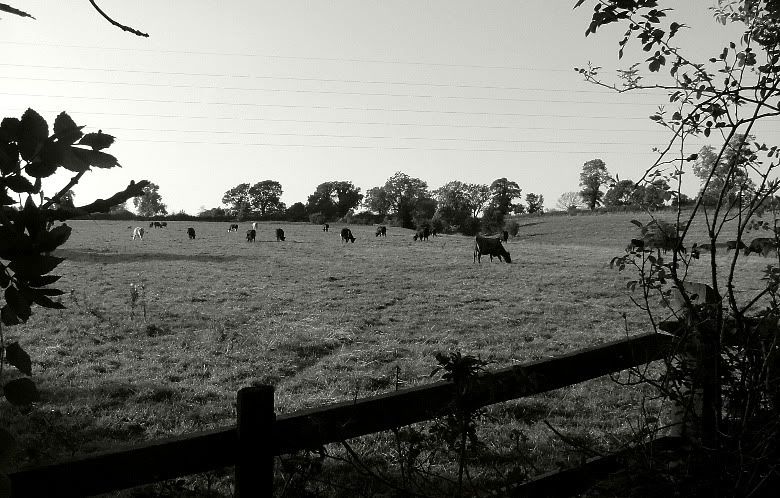
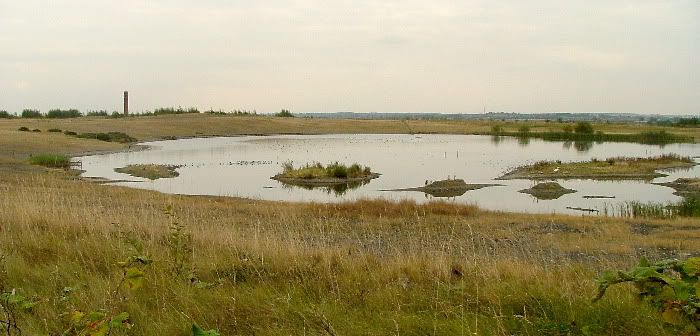
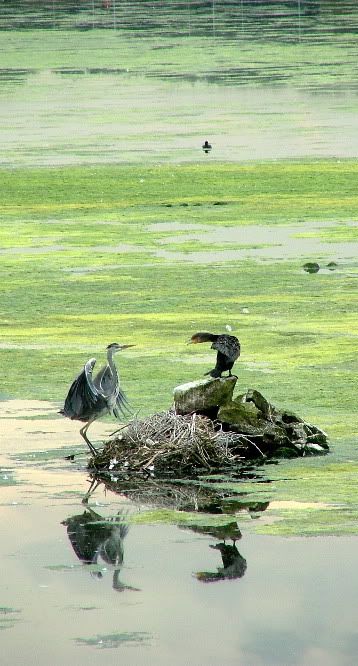



3 comments:
Yay, you introduced a couple to birds, shouter and not-tellinger!
Well, one doesn't want to blow one's own trumpet now.
Hi James,
I agree with you, Pleasley could be 'massive' if it was watched properly. I've done my fair share of pit top watching and the rewards can be awesome if its hammered by one or two hardcore patchwatchers.
Its a shame its on the 'dark-side' of the Notts/Derbys border or I may, no I would, have deflected and made that my patch!
Post a Comment